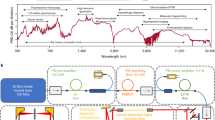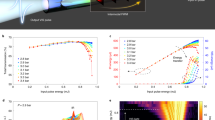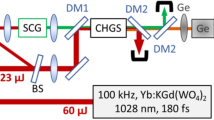Abstract
High-brightness sources of coherent and few-cycle-duration light waveforms with spectral coverage from the ultraviolet to the terahertz would offer unprecedented versatility and opportunities for a wide range of applications from bio-chemical sensing1 to time-resolved and nonlinear spectroscopy, and to attosecond light-wave electronics2,3. Combinations of various sources with frequency conversion4,5 and supercontinuum generation6,7,8,9 can provide relatively large spectral coverage, but many applications require a much broader spectral range10 and low-jitter synchronization for time-domain measurements11. Here, we present a carrier-envelope-phase (CEP)-stable light source, seeded by a mid-infrared frequency comb12,13, with simultaneous spectral coverage across seven optical octaves, from the ultraviolet (340 nm) into the terahertz (40,000 nm). Combining soliton self-compression and dispersive wave generation in an anti-resonant-reflection photonic-crystal fibre with intra-pulse difference frequency generation in BaGa2GeSe6, the spectral brightness is two to five orders of magnitude above that of synchrotron sources. This will enable high-dynamic-range spectroscopies and provide numerous opportunities in attosecond physics and material sciences14,15.
This is a preview of subscription content, access via your institution
Access options
Access Nature and 54 other Nature Portfolio journals
Get Nature+, our best-value online-access subscription
$29.99 / 30 days
cancel any time
Subscribe to this journal
Receive 12 print issues and online access
$209.00 per year
only $17.42 per issue
Buy this article
- Purchase on Springer Link
- Instant access to full article PDF
Prices may be subject to local taxes which are calculated during checkout




Similar content being viewed by others
Data availability
The data that support the plots within this paper and other findings of this study are available from the corresponding author upon reasonable request.
Code availability
The numerical code used in this work will be made available upon reasonable request.
References
Borrego-Varillas, R. et al. Two-dimensional UV spectroscopy: a new insight into the structure and dynamics of biomolecules. Chem. Sci. 10, 9907–9921 (2019).
Schiffrin, A. et al. Optical-field-induced current in dielectrics. Nature 493, 70–74 (2013).
Langer, F. et al. Lightwave-driven quasiparticle collisions on a subcycle timescale. Nature 533, 225–229 (2016).
Baudisch, M., Wolter, B., Pullen, M., Hemmer, M. & Biegert, J. High power multi-color OPCPA source with simultaneous femtosecond deep-UV to mid-IR outputs. Opt. Lett. 41, 3583–3586 (2016).
Liang, H. et al. High-energy mid-infrared sub-cycle pulse synthesis from a parametric amplifier. Nat. Commun. 8, 141 (2017).
Silva, F. et al. Multi-octave supercontinuum generation from mid-infrared filamentation in a bulk crystal. Nat. Commun. 3, 807 (2012).
Hudson, D. D., Baudisch, M., Werdehausen, D., Eggleton, B. J. & Biegert, J. 1.9 octave supercontinuum generation in a As2S3 step-index fiber driven by mid-IR OPCPA. Opt. Lett. 39, 5752–5755 (2014).
Vasilyev, S. et al. Super-octave longwave mid-infrared coherent transients produced by optical rectification of few-cycle 2.5-μm pulses. Optica 6, 111–114 (2019).
Mitrofanov, A. V. et al. Ultraviolet-to-millimeter-band supercontinua driven by ultrashort mid-infrared laser pulses. Optica 7, 15–19 (2020).
Muraviev, A. V., Smolski, V. O., Loparo, Z. E. & Vodopyanov, K. L. Massively parallel sensing of trace molecules and their isotopologues with broadband subharmonic mid-infrared frequency combs. Nat. Photon. 12, 209–214 (2018).
Pupeza, I. et al. Field-resolved infrared spectroscopy of biological systems. Nature 577, 52–59 (2020).
Thai, A., Hemmer, M., Bates, P. K., Chalus, O. & Biegert, J. Sub-250-mrad, passively carrier-envelope-phase-stable mid-infrared OPCPA source at high repetition rate. Opt. Lett. 36, 3918–3920 (2011).
Elu, U. et al. High average power and single-cycle pulses from a mid-IR optical parametric chirped pulse amplifier. Optica 4, 1024–1029 (2017).
Rini, M. et al. Transient electronic structure of the photoinduced phase of Pr0.7Ca0.3MnO3 probed with soft X-ray pulses. Phys. Rev. B 80, 155113 (2009).
Mitrano, M. et al. Possible light-induced superconductivity in K3C60 at high temperature. Nature 530, 461–464 (2016).
Demtröder, W. Laser Spectroscopy 2—Experimental Techniques (Springer, 2015).
Wright, J. C. Multiresonant coherent multidimensional spectroscopy. Annu. Rev. Phys. Chem. 62, 209–230 (2011).
Chang, C.-I. Hyperspectral Imaging (Springer, 2003).
Bertrand, L. et al. Cultural heritage and archaeology materials studied by synchrotron spectroscopy and imaging. Appl. Phys. A 106, 377–396 (2012).
Jamin, N. et al. Highly resolved chemical imaging of living cells by using synchrotron infrared microspectrometry. Proc. Natl Acad. Sci. USA 95, 4837–4840 (1998).
Langer, F. et al. Lightwave valleytronics in a monolayer of tungsten diselenide. Nature 557, 76–80 (2018).
Silva, R. E. F., Jiménez-Galán, Amorim, B., Smirnova, O. & Ivanov, M. Topological strong-field physics on sub-laser-cycle timescale. Nat. Photon. 13, 849–854 (2019).
Köttig, F., Tani, F., Biersach, C. M., Travers, J. C. & Russell, P. S. J. Generation of microjoule pulses in the deep ultraviolet at megahertz repetition rates. Optica 4, 1272–1276 (2017).
Travers, J. C., Grigorova, T. F., Brahms, C. & Belli, F. High-energy pulse self-compression and ultraviolet generation through soliton dynamics in hollow capillary fibres. Nat. Photon. 13, 547–554 (2019).
Pupeza, I. et al. High-power sub-two-cycle mid-infrared pulses at 100-MHz repetition rate. Nat. Photon. 9, 721–724 (2015).
Hoogland, H. et al. All-PM coherent 2.05-µm thulium/holmium fiber frequency comb source at 100 MHz with up to 0.5-W average power and pulse duration down to 135 fs. Opt. Express 21, 31390–31394 (2013).
Kowligy, A. S. et al. Infrared electric-field sampled frequency comb spectroscopy. Sci. Adv. 5, eaaw8794 (2019).
Badikov, V. V. et al. Crystal growth and characterization of new quaternary chalcogenide nonlinear crystals for the mid-IR: BaGa2GeS6 and BaGa2GeSe6. Opt. Mater. Express 6, 2933–2938 (2016).
Elu, U. et al. Few-cycle mid-infrared pulses from BaGa2GeSe6. Opt. Lett. 45, 3813–3815 (2020).
Lesko, M. B. et al. A six-octave optical frequency comb from a scalable few-cycle erbium fiber laser. Preprint at https://arxiv.org/abs/2005.13673 (2020).
Tani, F., Travers, J. C. & St.J. Russell, P. Multimode ultrafast nonlinear optics in optical waveguides: numerical modeling and experiments in Kagomé photonic-crystal fiber. J. Opt. Soc. Am. B 31, 311–320 (2014).
Porer, M., Ménard, J.-M. & Huber, R. Shot noise reduced terahertz detection via spectrally postfiltered electro-optic sampling. Opt. Lett. 39, 2435–2438 (2014).
Knorr, M. et al. Ultrabroadband etalon-free detection of infrared transients by van-der-Waals contacted sub-10-µm GaSe detectors. Opt. Express 26, 19059–19066 (2018).
Zeisberger, M. & Schmidt, M. A. Analytic model for the complex effective index of the leaky modes of tube-type anti-resonant hollow core fibers. Sci. Rep. 7, 11761 (2017).
Tani, F., Köttig, F., Novoa, D., Keding, R. & Russell, P. S. J. Effect of anti-crossings with cladding resonances on ultrafast nonlinear dynamics in gas-filled photonic crystal fibers. Photon. Res. 6, 84–88 (2018).
Vincetti, L. & Rosa, L. A simple analytical model for confinement loss estimation in hollow-core tube lattice fibers. Opt. Express 27, 5230–5237 (2019).
Couairon, A. & Mysyrowicz, A. Femtosecond filamentation in transparent media. Phys. Rep. 441, 47–189 (2007).
Acknowledgements
J.B. and his group acknowledge financial support from the European Research Council via ERC Advanced Grant ‘TRANSFORMER’ (788218) and ERC Proof of Concept Grant ‘mini-X’ (840010), the European Union’s Horizon 2020 for FET-OPEN ‘PETACom’ (829153), FET-OPEN ‘OPTOlogic’ (899794), Laserlab-Europe (EU-H2020 654148), Marie Skłodowska-Curie grant no. 860553 (‘Smart-X’), MINECO for Plan Nacional FIS2017-89536-P, AGAUR for 2017 SGR 1639, MINECO for ‘Severo Ochoa’ (SEV- 2015-0522), Fundació Cellex Barcelona, CERCA Programme/Generalitat de Catalunya and the Alexander von Humboldt Foundation for the Friedrich Wilhelm Bessel Prize. We thank I. Tyulnev and M. Enders for their assistance.
Author information
Authors and Affiliations
Contributions
J.B. conceived and supervised the project. U.E. performed the experiments and analysed the results with help from L.V. and L.M. V.B., D.B. and V.P. provided the BGGSe crystal. F.T., D.N., M.H.F. and P.St.J.R. provided the ARR-PCF fibre together with experimental support and the simulations of self-compression. L.M. and J.B. wrote the manuscript.
Corresponding author
Ethics declarations
Competing interests
The authors declare no competing interests.
Additional information
Peer review information Nature Nanotechnology thanks the anonymous reviewers for their contribution to the peer review of this work.
Publisher’s note Springer Nature remains neutral with regard to jurisdictional claims in published maps and institutional affiliations.
Supplementary information
Supplementary Information
Supplementary Fig. 1 and Methods.
Rights and permissions
About this article
Cite this article
Elu, U., Maidment, L., Vamos, L. et al. Seven-octave high-brightness and carrier-envelope-phase-stable light source. Nat. Photonics 15, 277–280 (2021). https://doi.org/10.1038/s41566-020-00735-1
Received:
Accepted:
Published:
Issue Date:
DOI: https://doi.org/10.1038/s41566-020-00735-1
This article is cited by
-
350-2500 nm supercontinuum white laser enabled by synergic high-harmonic generation and self-phase modulation
PhotoniX (2023)
-
Highly efficient octave-spanning long-wavelength infrared generation with a 74% quantum efficiency in a χ(2) waveguide
Nature Communications (2023)
-
GaAs-chip-based mid-infrared supercontinuum generation
Light: Science & Applications (2023)
-
Intense ultraviolet–visible–infrared full-spectrum laser
Light: Science & Applications (2023)
-
Single-cycle infrared waveform control
Nature Photonics (2022)



